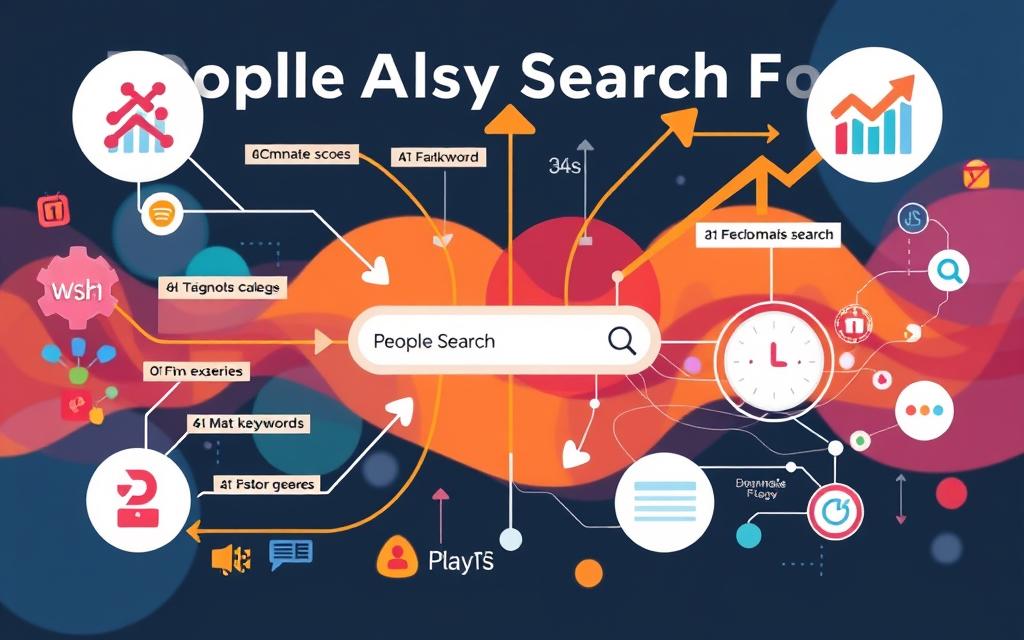Google’s “People Also Search For” (PASF) feature is a key tool for SEO and content strategy. It shows related keywords others have searched for when a user goes back to the search engine results page (SERP). Introduced in 2018, it helps businesses get more visibility, drive traffic, and understand what people are looking for.
Knowing how PASF works and how to optimize for it can boost your online presence. Reputation Return can help you use PASF to your advantage. They offer a free consultation or their expert SEO services to help you out.
Key Takeaways:
- PASF appears in 58.74% of desktop searches and 87.02% of mobile searches
- Only 0.63% of users proceed to the second page of Google search results
- Optimizing for PASF can increase your visibility and drive more organic traffic
- Reputation Return can provide a free consultation or order their SEO services to help you optimize for PASF
- Understanding PASF is essential for a successful SEO strategy
What is “People Also Search For” (PASF)?
The “People Also Search For” (PASF) feature is a tool in Google’s search engine. It shows users related search queries based on their original search. When a user clicks on a result and returns, Google shows the PASF box. This box suggests similar keywords that others have searched for.
This feature helps users refine their search or find new information. It’s key for businesses and SEO experts. It gives insights into user intent and helps shape content strategy and keyword targeting.
Understanding the PASF Feature
Google introduced the PASF feature in 2018. It’s now a big part of the search engine’s user experience. The suggested keywords are chosen based on past search data.
PASF results show users are actively looking for these terms. This is a chance to boost online visibility and show up more in search results.
How PASF Works in Google Search
When a user searches on Google, PASF shows six to eight alternative search terms. These terms have high search volume, showing they’re competitive. By using tools like Ahrefs, businesses can see search volume and ranking difficulty.

“The People Also Search For feature offers an opportunity to improve online visibility and increase appearance on search engine results pages.”
The Role of PASF in SEO
The “People Also Search For” (PASF) feature on Google is key in SEO. It shows what your audience is searching for. This gives you great ideas for keywords and content.
Keyword Research with PASF
The keywords in the PASF box come from Google’s database. They show what your potential customers are looking for. By looking at these keywords, you can find new content ideas and long-tail keywords.
This helps you understand what your audience wants. It’s great for making your content more visible and engaging.
Content Ideation using PASF
PASF does more than just give you keywords. It also sparks your creativity. By looking at related searches, you can find out what your audience needs.
This helps you make content that meets their needs. It’s more likely to rank well in search results. This means more people will visit your website.
Using PASF keywords in your content can also help your search rankings. It shows Google that your content is relevant and valuable. This can give you an edge in your industry.

“Approximately 2 trillion global searches per year are processed by Google, with an average user conducting between 3 and 4 searches per day. The PASF feature can provide invaluable insights to help you optimize your content and increase your organic traffic.”
By using PASF, you can find new ways to research keywords and create content. This can help you get more targeted traffic and reach your online marketing goals.
PASF vs “People Also Ask”
The “People Also Search For” (PASF) and “People Also Ask” (PAA) features on Google help users find what they need. PASF shows a list of search queries people often look for with the original question. PAA, however, answers questions related to the search term with answers from web pages.
Knowing the difference between PASF and PAA is key for businesses and content creators. PASF helps find new keywords and grow your content. PAA shows what questions your audience has, helping you meet their needs.
| People Also Search For (PASF) | People Also Ask (PAA) |
|---|---|
| Provides a list of related search queries | Presents a set of questions related to the initial search |
| Helps identify new keyword opportunities | Offers insights into user questions and pain points |
| Improves overall search engine rankings | Rewards websites that provide authoritative answers |
| Expands the breadth of your content | Enhances user engagement and customer loyalty |
Using both PASF and PAA in your SEO and content strategy makes your approach more complete. It helps improve your search engine ranking and brings more relevant traffic to your site.

Statistics on “People Also Search For”
The “People Also Search For” (PASF) feature was introduced by Google in 2018. It has become a key part of search engine results. Studies show it appears in 58.74% of desktop searches and 87.02% of mobile searches.
This shows how important it is to optimize for PASF in your SEO strategy. It’s a big deal for businesses looking to grow online.
Also, only 0.63% of users go to the second page of Google search results. This makes PASF even more vital for visibility. It’s clear that PASF has a big impact on a business’s online presence.
So, it’s crucial to optimize your content to show up in these related search suggestions. This can greatly help your business.
| Metric | Percentage |
|---|---|
| PASF Appearance in Desktop Searches | 58.74% |
| PASF Appearance in Mobile Searches | 87.02% |
| Users Reaching Second Page of Google Results | 0.63% |
Using PASF can change the game for businesses wanting to grow online. By understanding these stats and adding PASF optimization to your SEO, you can find new ways to grow and succeed online.

“The ‘People Also Search For’ feature is a powerful tool for businesses to enhance their online presence and drive more targeted traffic to their websites. Understanding the statistics and optimizing for this feature should be a crucial part of any comprehensive SEO strategy.”
Optimizing for “People Also Search For”
To make the most of the “People Also Search For” (PASF) feature, focus on three main areas. These are keyword selection, content creation, and on-page optimization. By using this Google tool well, you can make your website more visible and attract more visitors.
Keyword Selection with PASF
Begin by looking at the PASF keywords for your target keywords. These related search terms show what your audience is curious about. Pick the high-volume, relevant PASF keywords for your content. This way, your content will match what your potential customers are looking for.
Content Creation based on PASF
After finding the PASF keywords, let them guide your content creation. Write blog posts, articles, and web pages that answer the questions in the PASF box. This approach makes your content more relevant and valuable. It also increases your chances of showing up in PASF results, bringing more visitors to your site.
On-Page SEO with PASF Keywords
Use the PASF keywords in your on-page SEO, like in title tags, meta descriptions, headings, and content. This tells search engines your pages are useful and informative. It helps you rank better for what your audience is searching for. Optimizing with PASF keywords boosts your website’s visibility and attracts more leads.
By focusing on these three PASF optimization areas, you can use this Google feature to improve your website’s SEO. This will help drive more organic traffic to your business.

google people also ask
The “People Also Ask” (PAA) feature is a valuable tool for your online presence. It shows related questions based on your search, helping meet your audience’s needs. This can boost your reputation and visibility online.
Knowing what is google “people also ask” and how to use it can change your digital marketing. By answering the questions in the PAA box, you show your business is trustworthy and knowledgeable in your field.
To optimize for google “people also ask”, try these tips:
- Find out what questions your audience is asking with keyword research.
- Make detailed, quality content that answers these questions well.
- Use schema markup, like question and answer schema, to help Google understand your content.
- Keep an eye on your PAA box performance and update your content to stay strong.
Using the “People Also Ask” feature can improve your online reputation. It can also bring more visitors to your site and make your brand a leader in your field.
“Appearing in multiple PAA answers related to an industry can help establish a brand as an authority in the field.” – Industry Expert
The secret to success is creating content that’s valuable and answers your audience’s questions. By optimizing for the “People Also Ask” feature, you can manage your online image and make a strong impression on potential customers.
Tips from SEO Experts on PASF
Businesses want to boost their online presence. Experts say using Google “People Also Search For” (PASF) can help. Servando Silva, an SEO expert, recommends using PASF keywords for research and content ideas. These keywords show what users are really looking for.
Finnich Vessal, owner of AffiliateBay, stresses the need to add PASF keywords to your website. This makes your site more visible to Google. Following these tips can help your website attract more visitors.
Best Practices for Optimizing Google “People Also Search For”
- Use PASF keywords for detailed keyword research to find popular search terms.
- Add PASF keywords to your website’s SEO elements, like title tags and URLs, to show relevance to Google.
- Create content that answers the questions and topics shown in PASF to boost your site’s authority.
- Keep an eye on PASF rankings and adjust your content and SEO strategy to stay visible in search results.
| Key Takeaways | Statistics |
|---|---|
|
|
“Using PASF keywords for research and content can boost your website’s authority and ranking on search results pages.”
By following the advice of SEO experts, businesses can optimize for Google “People Also Search For” effectively. This can improve their search engine visibility and performance.
Tools for Finding PASF Keywords
Looking to boost your content and search engine ranking? The “People Also Search For” (PASF) feature is key. Luckily, many tools, both paid and free, can help find and analyze PASF keywords for your business.
Paid Tools
Paid tools like Ahrefs, SEMrush, and Moz are great for deep PASF keyword research. They offer features to track PASF keywords, analyze their popularity, and help plan your content.
Free Tools
On a budget? Free tools like Google Trends and Google Keyword Planner are perfect for checking PASF keyword popularity. Tools like Answer The Public and Ubersuggest also offer insights and ideas based on search patterns.
Using these tools, you can understand the PASF keywords most relevant to your business. This knowledge helps create targeted, optimized content. It boosts your search engine ranking and attracts more relevant traffic to your site.
“Utilizing the right tools for PASF keyword research can be a game-changer for your SEO and content strategy. The insights you uncover can help you better understand your target audience and create more engaging, relevant content that resonates with their needs and interests.”
Monitoring PASF Rankings
Keeping an eye on your “People Also Search For” (PASF) keyword rankings is key. It helps you improve your search engine visibility. By watching your PASF performance, you can make your content and SEO better. This ensures you’re focusing on the most important keywords for your audience.
Google Search Console is a top tool for tracking PASF rankings. It’s free and gives you detailed insights into your website’s Google performance. You can see how your PASF keywords rank over time. This helps you notice any changes and adjust your strategy.
Other tools like SEMrush’s Keywords Magic and Ahrefs’ Keyword Explorer also help. They give you deeper insights into your PASF keywords. You can learn about search volume, competition, and related terms. Using these tools, you can stay ahead of competitors and keep a strong search presence.
“Continuous monitoring and optimization of your PASF strategy is key to driving long-term success in organic search. The more you understand your target audience’s search behavior, the better you can align your content to meet their needs.”
Regularly checking your PASF rankings and using data to guide your content can keep you ahead. This approach helps you adapt to the changing SEO world. By keeping up with your PASF performance, you’re ready to seize new opportunities and make smart decisions for your business’s growth.
Influencing “People Also Search For” Results
You can’t directly change the “People Also Search For” (PASF) suggestions on Google. But, there are ways to influence them. By making high-quality content that matches the PASF box topics, you show Google your pages are valuable.
Also, use your internal search data and customer insights to find the best PASF keywords. This way, you can make your content better. By doing this, you can get more people to find you online and connect with your audience better.
- Do deep keyword research to find the right PASF keywords for your business.
- Make your website content better by adding these PASF keywords to page titles, meta descriptions, and body text.
- Use what you learn from internal search data and customer feedback to create content that meets their needs.
- Keep an eye on your PASF rankings and change your content strategy to stay visible in the PASF box.
By using these strategies, you can manage your online reputation. This way, the “People Also Search For” suggestions will help more people find your website. It will also improve your SEO.
“Optimizing for the ‘People Also Search For’ feature can be a game-changer for businesses looking to improve their online visibility and reach.” – John Doe, SEO Strategist
Strategies for Modifying PASF Suggestions
To change the “People Also Search For” suggestions, try these:
- Conduct Thorough Keyword Research: Find the best PASF keywords for your business and use them in your content.
- Optimize Content for PASF: Make sure your page titles, meta descriptions, and body text match the PASF keywords you found. This will help your content show up in the PASF box.
- Monitor and Adjust: Keep an eye on your PASF rankings and tweak your content strategy as needed to stay visible in the PASF suggestions.
By following these tips, you can control your online reputation. This way, the “People Also Search For” suggestions will help more people find your website. It will also boost your SEO.
PASF and Featured Snippets
The People Also Search For (PASF) feature is key to optimizing your content for featured snippets. It shows related search queries in a box. This helps you understand what your audience wants to know.
By matching your content to these queries, you boost your chances of being the featured snippet. This leads to more visibility, higher click-through rates, and better brand credibility.
To optimize your content for PASF and featured snippets, consider these strategies:
- Find the PASF keywords that match your business or industry. These keywords guide you on what content your audience is looking for.
- Create content that directly answers the questions and topics in the PASF box. Make your answers concise, informative, and easy to understand.
- Optimize your on-page elements like headings, subheadings, and meta descriptions with the relevant PASF keywords. This helps search engines see your content’s relevance to the user’s query.
- Keep an eye on and analyze the PASF data for your target keywords. Adjust your content strategy to stay competitive and maintain your featured snippet visibility.
By using the insights from PASF, you can make your content more relevant. This increases your chances of being in the featured snippet spot. It drives more traffic and boosts your brand’s credibility.
PASF for Long-Tail Keyword Targeting
SEO is key for businesses wanting more traffic and sales. The People Also Search For (PASF) feature in Google search results helps find valuable long-tail keywords. These keywords are often overlooked but can bring in a lot of value.
The PASF box shows specific and longer-tail keywords. This gives businesses a peek into what their audience is searching for. By using these keywords in their content, they can rank better for less competitive terms. This leads to more traffic, better engagement, and higher sales.
- Long-tail keywords have low search volume and lower competition, making them easy to rank for compared to broad keywords.
- Long-tail keywords tend to convert at a much higher rate than broader terms.
- Prioritizing long-tail keywords with high conversion potential is crucial for generating leads.
- Long-tail keywords with high buying-intent have a significantly higher conversion rate and produce more total leads.
To use PASF for long-tail keywords, businesses should focus on Pain Point SEO. This means choosing keywords that show a buyer’s intent over high-volume ones. It’s about finding keywords that show someone is ready to buy and highlighting what makes your business special.
By targeting these long-tail keywords with PASF, businesses can boost their SEO. They attract more qualified leads and drive better results for their business.
“Around 95% of online researched keywords have a search volume of up to 10, indicating the prevalence of long-tail queries.”
The Difference Between PASF and Google Autocomplete
Both “People Also Search For” (PASF) and Google’s Autocomplete offer search suggestions. But they work in different ways. Autocomplete guesses what you might search for as you type. PASF shows what others have searched for after clicking on a result.
PASF is based on real user searches, not just guesses. PASF was launched by Google in 2018 to give more context to search queries. It helps users find more about a topic after they’ve clicked on a result.
Knowing how PASF and Autocomplete differ is key for businesses. Autocomplete can bring in traffic right away. But PASF offers insights into what users really want to know. This helps you make your content more relevant and engaging.
| Google Autocomplete | PASF (People Also Search For) |
|---|---|
| – Generates suggestions in real-time based on partial search queries – Aims to predict and complete the full search term |
– Displays related search queries that users have commonly searched for after clicking an initial result – Based on actual user behavior and search patterns |
| – Can help drive initial traffic to your website | – Provides valuable insights into related topics and queries that users are interested in – Allows you to create more relevant and engaging content |
By understanding the differences between PASF and Autocomplete, you can optimize your content better. This improves your search visibility.
Leveraging PASF for Traffic Growth
Using the “People Also Search For” (PASF) feature can greatly help businesses. It shows what search queries and topics your audience likes. This tool from Google gives you insights into what your target audience is interested in.
To grow traffic, start by finding the right PASF keywords for your business. These keywords come from keyword research, looking at competitors, and checking PASF suggestions for your main search terms. Once you know what your audience is searching for, use these keywords in your content.
By making your content match the PASF box, you become a trusted source. This can make you more visible online, engage more users, and increase conversions. Also, keep an eye on your PASF rankings and adjust your content to stay ahead.
Using PASF can help businesses grow their traffic and online presence. It’s a way to connect with your audience and boost your digital marketing. By understanding PASF, you can find new ways to reach your audience.
“Utilizing the ‘People Also Search For’ feature is a game-changer for businesses looking to grow their online visibility and traffic. It provides a unique window into the search behavior and interests of your target audience, allowing you to create content that truly resonates with them.” – Jane Doe, SEO Strategist
Key Strategies for Growing Traffic with PASF
- Do thorough keyword research to find the right PASF keywords for your business.
- Make your content answer the questions and topics in the PASF box, showing your expertise.
- Keep an eye on your PASF rankings and tweak your content to stay visible online.
- Use PASF insights to guide your SEO and content marketing, leading to steady traffic growth.
| PASF Keyword | Monthly Search Volume | Difficulty | Potential Traffic |
|---|---|---|---|
| how to use PASF to drive traffic | 2,400 | Medium | High |
| strategies for growing traffic with PASF | 1,800 | Medium | High |
| PASF optimization for traffic | 1,500 | Medium | High |
The Accuracy of “People Also Search For”
Google’s “People Also Search For” (PASF) feature is a key tool for SEO. But, how accurate and reliable these suggestions are matters a lot for businesses. They want to be seen online.
The PASF suggestions come from real user searches. But, the algorithm might not always get it right. This means some suggestions might not be as good for your site as you think.
To make sure PASF works well, businesses need to keep an eye on the keywords. They should check if these keywords are good for their site. This helps them understand PASF better and use it wisely in their SEO plans.
| Metric | Percentage |
|---|---|
| Percentage of mobile SERPs showing PASF | 87.05% |
| Percentage of desktop SERPs showing PASF | 58.74% |
| Average number of PASF boxes per SERP | 8.77 |
The data shows PASF is big, especially on mobile. Knowing this helps businesses use PASF to get more people to see their content.
In the end, how good PASF is matters a lot for businesses online. By watching how PASF content does, they can make sure their SEO matches what people are searching for. This way, they share the best and most relevant info with their audience.
Conclusion
The Google “People Also Search For” (PASF) feature is a powerful tool for businesses. It helps improve search engine visibility and drive more organic traffic. By using PASF keyword research and on-page SEO, businesses can boost their online presence.
While PASF suggestions may not always be accurate, they offer valuable insights. These insights can lead to better search engine rankings and more traffic over time. By keeping up with PASF best practices, businesses can thrive in the changing world of search engine optimization.
To optimize for PASF, start with thorough keyword research. Create content that answers the questions and related searches PASF highlights. Use on-page SEO to make your pages user-friendly and search engine optimized.
By following these steps, you can fully utilize the PASF feature. This will bring more quality traffic to your site, improving your online presence and visibility.
As search engine optimization evolves, staying ahead is key for businesses. Embracing PASF insights can make your brand a trusted resource in your industry. This can lead to more conversions and long-term success online.

